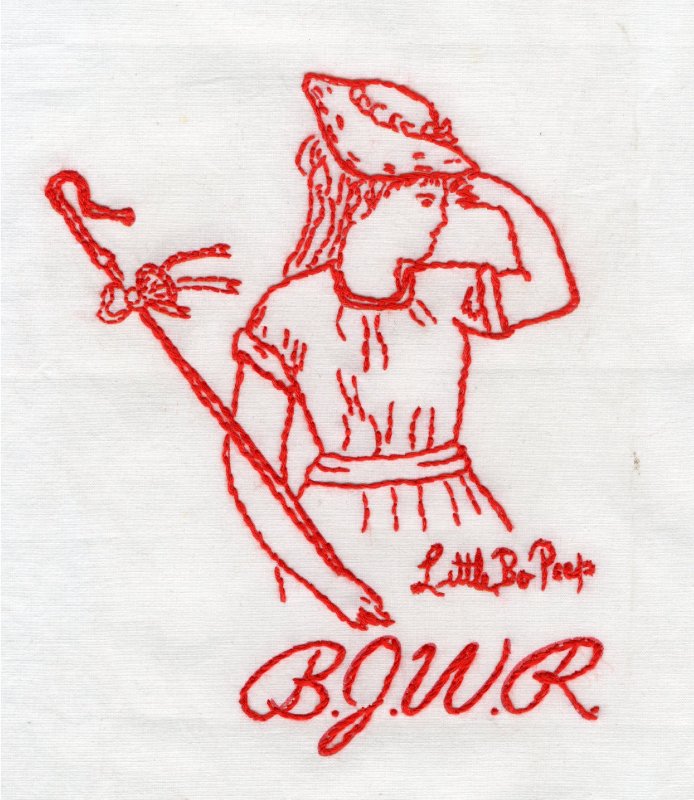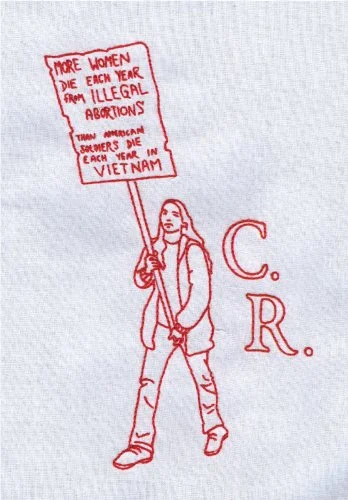Q,R
Kaylee Rae
“I respect the power of images and how the pictures from Abu Ghraib, the Vietnam war and of police brutality disturbed the public so profoundly that it drove them to action. I know how important it is to reflect on them and they are certainly have a necessary place in this installation. but, i could not reconcile stitching one of these images with my own hands, knowing it would mean hours engaged with such an image and absorbing the pain it evoked. I chose a pattern of a confederate soldier statue folded on itself, collapsed into a heap of trashed metal, because it as an image I can revel in. I wanted to stitch an image of the people uniting to dismantle symbols of oppression, to remind us all that we have the power to break these systems down.”
Joy Rafey
“‘I love Persian food!’ my daughter announced as she returned from a visit next door. She’d been playing with our new neighbor Sarah, whose grandmother prepared snacks for them. This grandmother, I would learn, had the courage and strength to move her family away from certain death at the hands of Iran’s revolutionaries, to a country where they would be treated as an exotic enemy for decades. Despite this treatment they persevered, and the family has flourished. Over the last 20 years I’ve watched their younger generations grow beside mine; I’ve attended this family’s weddings and funerals, birthday parties and graduations. I regret that our country wasn’t more welcoming to them in their time of need, but I’m forever grateful they escaped persecution and it's an honor to have them as neighbors - and dear friends.”
Joy Rafey
“Jefferson Davis, the president of the US Confederacy, sits on a far-flung branch of my family tree. We’re a solidly Northern family however, and our folk fought in the Union army. Still, family connections to historical figures is notable, so we’ve kept our inherited ‘Jefferson Davis bowl’ in a glass case, though pushed to the back of a darkened shelf. And that’s where monuments to oppressionists belong – in the dark recesses of history and not in the center of the public square. My generation is the first to share the story of our bowl with candor and not reverence. This in no way diminishes us; rather, it builds our fortitude to challenge the status quo with an honest assessment of our distant ancestor’s infamy. And that’s what needs to happen with monuments to oppressors: a reckoning with their true legacy that includes reinterpretation and relocation. The iconography of the image I’m stitching includes the reinterpretation of Jackson’s legacy by adding ‘KILLER’ to the statue’s base, and an attempt at removal from the public square that served as an inflection point during this summer’s protests. I live near Lafayette Square and find it fascinating that today the park is a dead zone because barriers have been erected to protect the statue and put greater distance between the public and the White House. Yet the street leading to the square, now known as Black Lives Matter Plaza, plays host to the most extreme expressions of human emotion from vehement protest, to atrocious oppression, to jubilant celebration.”
Barbara Rehus
“Little Bo Peep’s hat reminded me of an embroidery my father made as a young boy and which he gave me when I was a little girl. He was terribly mistreated as a child and grew up to be an angry abusive man. I’m thinking of the lifelong weird and painful mix of love, beauty and child abuse.”
Barbara Rehus
Peggy Taylor Reid
“This image was part of my photography education. Later in my life I discovered more about the photographer and gunman in the photograph. The history behind the movement, both for the photographer and executioner, are what haunts me still about some documentary photography. The space before and after the moment are never seen or felt. ..somehow erased visually.”
Carolina Reis
“I am deeply concerned with the issue . I find the repeated violence in schools and the shootings very disturbing.”
Carolina Reis
Carolina Reis
Tatjana Reithofer
“Pepe the Frog is such a contentious meme. He is a hate symbol to some, he is a symbol of the trickster to the politically neutral, and he is a symbol of empowerment for the Alt Right. Pepe is the quintessential image/symbol of the times we live in - chaotic on both ends.
Like the biblical plague of frogs bestowed upon Ramses’ Egypt, we are going through our own plague - witnessing harbingers of chaos.
I appreciate the duality present in this project”
Tatjana Reithofer
Teresa Remus
Ryan Rice
“I have a title for the image I worked on with (the redwork) circle, “Ward." I also like that as a statement. ”
Clothilde Richer
“Simone de Beauvoir avait raison : ces droits que l’on croyait acquis nous sont retirés peu a peu. Nous devons rester vigilantes et poursuivre la bataille menée par nos mères et grand-mères.”
Alysha Rocca
“I chose this image because I was inspired by botany from the book "Braiding Sweetgrass" by Robin Wall Kimmer.”
Lee Rodney
Emily Roe
“I choose this pattern as a way to mourn with the women and children who have had to live through wartimes.”
Brigitte Romao
“For many, Columbus is a symbol of the atrocities committed against Indigenous Americans and a constant reminder of the harm caused by colonization. The removal of not just his monument but that of other historical figures aided in colonization are a step in the right direction towards decolonizing North America.”
Victor Romao
“Living in close proximity to the United States has exposed Canadians to many stories about the Vietnam war. I didn't fully understand the politics and impact this war had on all parties involved until I watched "The Vietnam War" documentary by Ken Burns. There are many comparisons that can be made with what happened in the 1960's with what's happening now...corrupt governments and racial inequality are just a couple that can be mirrored.”
Jill Rosenberg
“I wanted an innocent image to contrast the dark. But I like this image because it also speaks to the predatory nature of animals and humans. The fish are kept in a bowl as pets for human entertainment (and) the cat is catching them. They don’t stand a chance.”
Jennifer Rudder
“I (chose this image because) I am working with the artist Mary Anne Barkhouse on exhibitions, and she lives on a beaver pond and makes sculptures in bronze of beavers."
Giovanna Russo-Romao
“This image is nostalgic, reminding me of books that I borrowed from the public library. The public library was housed in the Willistead Manor at the time. It is one the fondest memories I have from my childhood.”
Lyla Rye
“This image is significant to Canada’s involvement in war.”






















